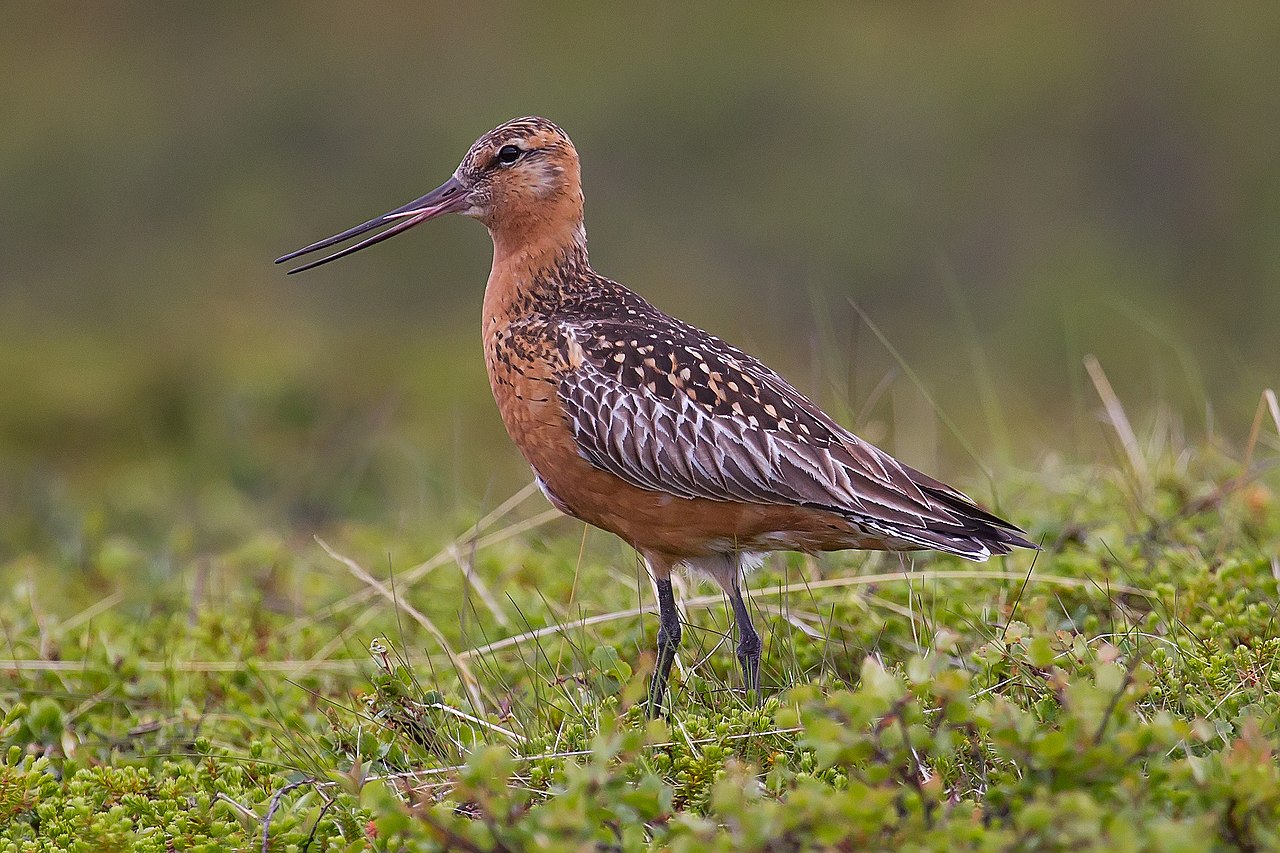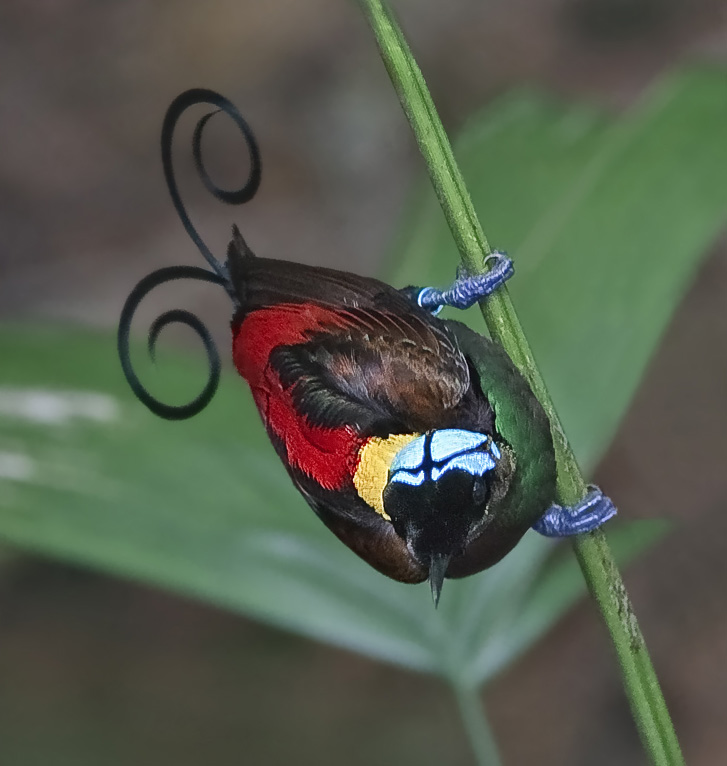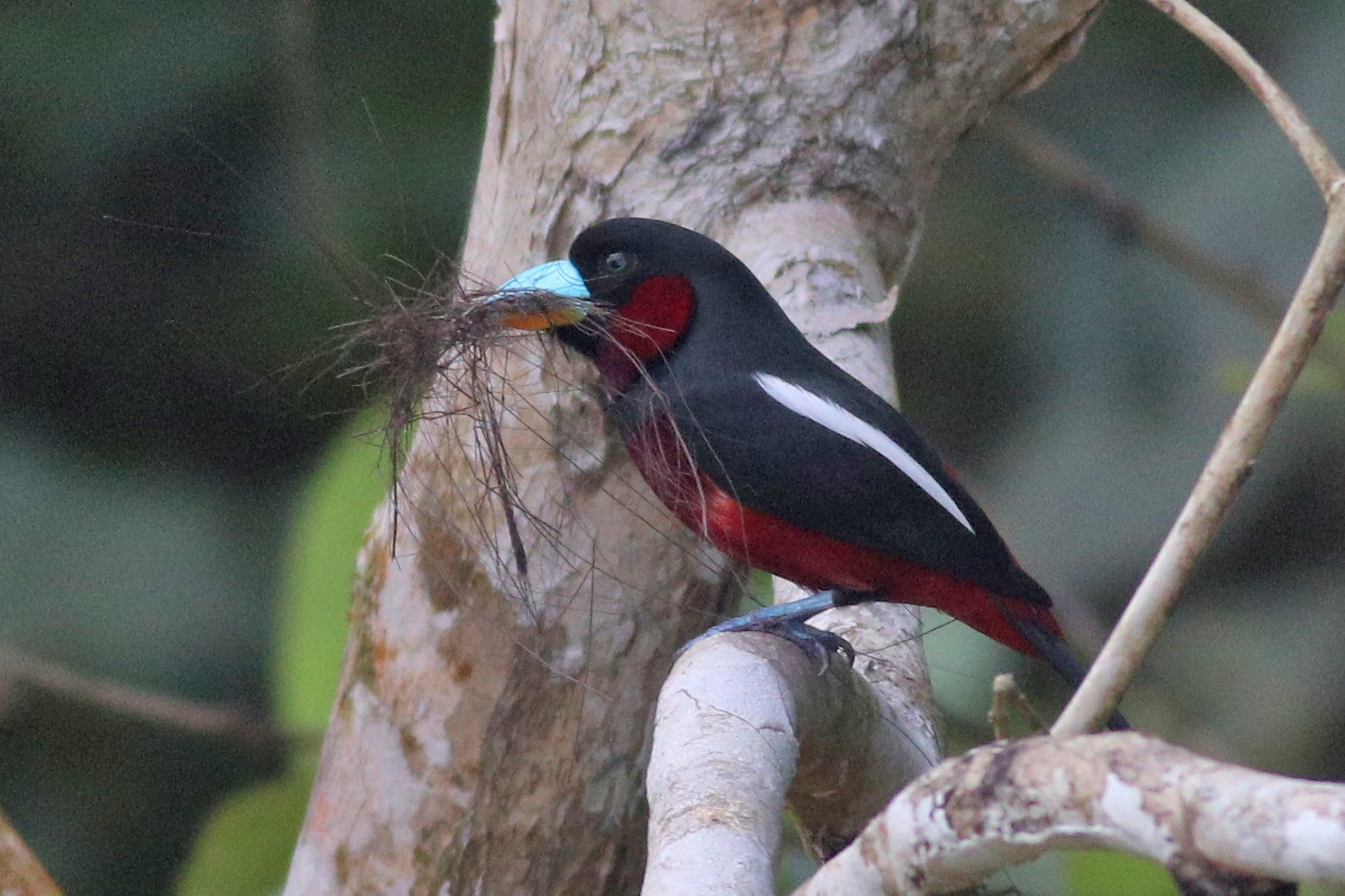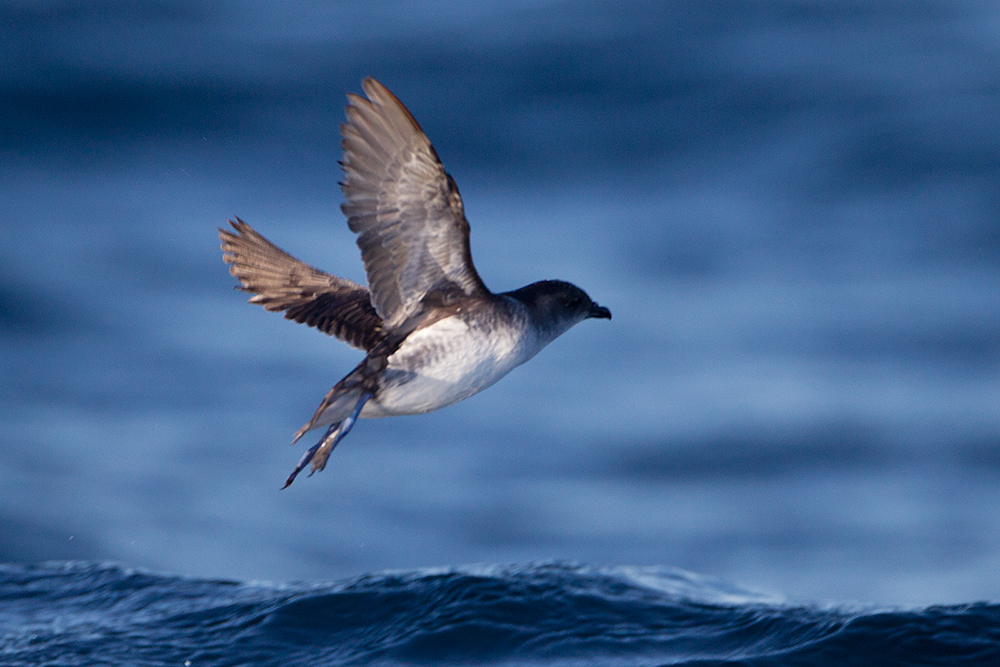Some of the rarest types of birds in the world have blue feet. This can be a breeding trait aimed to attract breeding partners or an adaptation to their environment.
From marine birds to parrots, different species show blue feet of different nuances. Some feet are only slightly blue while others are bright blue and contrasting to the plumage.
All of the following species have blue legs and may be spotted in different areas of the world as residents or as migratory birds.
Table of Contents
1. Blue-footed Booby
Growing up to a size of 35 inches, Blue-Footed Boobies (Sula nebouxii) are known for their bright blue feet.
These birds use their blue feet to attract the attention of the opposite sex.

Males lift their feet and perform different movements in front of the female to impress them during the breeding season.
The blue feet of Blue-footed Booby birds aren’t always of the same shade. While bright blue, they can be closer to white or closer to purple, depending on each individual.
Named after their blue feet, Blue-footed Booby birds are aquatic birds that can dive for fish.
Apart from their legs adapted to their habitat, these birds are also known to breathe from the corners of their beaks instead of the nostrils when diving for fish.
Distribution – The Pacific Coast of the Southern US, The Pacific Coast of Central America, The Pacific Coast of Northern South America
Blue feet nuance – turquoise
2. Keel-billed Toucan

Keel-billed Toucans (Ramphastos sulfuratus) have a contrasting and multicolored appearance. Birds of the species have mostly black plumage with blue feet.
Its blue feet contrast with its black belly and chest while the neck and face of the species are yellow.
The crown is black while the beak shows a combination of green and orange colors.
In some regions, the beak of The Keel-billed Toucan is green, orange, and red-brown at the tip.
Its large bill helps the species have a diverse diet that includes invertebrates, lizards, and even small birds.
Reaching a size of up to 5.9 inches, Keel-billed Toucans live in rainforests across tropical and subtropical climates of The Americas.
Distribution – Mexico, Belize, Guatemala, Panama, Nicaragua, Costa Rica, Colombia
Blue feet nuance – bright blue
3. Blue-billed Teal

Male Blue-billed Teals (Spatula hottentota) have blue or blue-gray feet. They differentiated themselves also by their blue bills.
These types of ducks have different nuances of brown with a dark brown crest.
Not much is known about the blue nuances and the plumage of these ducks apart from males becoming brighter in the breeding season.
With the capacity to attract attention, brighter brown males may stand out to females more, although their blue nuances on the feet and bill remain the same.
Different types of water sources are ideal for these ducks. They vary from lakes to mudflats but many Blue-billed Teals live in water with other animals.
Distribution – sub-Saharan Africa
Blue feet nuance – blue-gray
4. Bar-tailed Godwit

The dark legs of the Bar-tailed Godwit (Limosa lapponica) have a blue tint. Only seen in this blue nuance on adults, the legs of the species contrast the vivid plumage of the adult birds.
For much of the year, this species has a gray or brown dominant color, depending on gender. These dull colors switch up for the breeding season both in males and females.
The Bar-tailed Godwit is a species where the male takes on a rusty-red color for the breeding season. Its rusty-red color is visible on its underbelly and nect.
Females also change to a bright orange color going into the breeding season.
Feeding on shellfish and other types of food found in coastal areas, The Bar-tailed Godwit is a species that uses its very long beak to find food underwater.
Bar-tailed Godwits are also known to have one of the longest migrations in the bird kingdom. They can travel from Northern Europe to South Africa and from Australia to Northern Asia.
Distribution – Alaska, Russia, Northern Europe, sub-Saharan Africa, Australia, New Zealand
Blue feet nuance – blue-gray
5. Masked Booby

Known as plunging birds that live in open waters, Masker Booby (Sula dactylatra) birds are born featherless.
Females of the species only lay 2 eggs. The first emerging featherless bird eats the other egg or the other emerging smaller bird.
It then turns into a feathered juvenile with dark brown and white coloring and a blue face.
Its feet are also blue, with significant gray sections.
As the bird matures, its legs become even brighter.
Some of the best times to spot blue-legged juveniles are in colonies along coastlines.
Distribution – The Atlantic Ocean, The Pacific Ocean, The Indian Ocean
Blue feet nuance – blue-gray
6. Fairy Prion

Some of the most remote islands in the oceans of the world are the home to Fairy Prions (Pachyptila turtur).
These are a type of seabirds with gray, white, and blue plumage, blue feet, and blue bills.
Reaching a maximum size of just under 10 inches, these birds are seen in very large colonies.
They fly just above the water to identify tiny fish to feed on. Their diet also includes invertebrates that are readily available in their oceans and along the islands, they live in large colonies.
The species is often seen around Australia but it also lives in almost all of the oceans of the world.
Millions of Fairy Prions live all around the world.
Distribution – The Atlantic Ocean, The Pacific Ocean, The Indian Ocean
Blue feet nuance – bright blue
7. Seychelles Warbler

Gray and brown nuances are specific to this remote bird species (Acrocephalus sechellensis). The legs of adults also have a base gray color with blue tints.
Seen across local woodlands in Seychelles, this specie is found in some of the densest woodlands in the area.
They are seen up on tree branches and flying among tree leaves looking for food. Some of the small insects that feed on trees and which may be pests are their main food.
Birds of this species rarely venture out to catch flying insects that pass by.
Warbling vocalizations are characteristic of these birds, as with most other types of warblers.
Distribution – Seychelles
Blue feet nuance – gray-blue
8. Eurasian Curlew

Found around marshes of Europe, The Eurasian Curlew (Numenius arquata) is also one of the species with blue legs. Its legs have a gray-to-blue color and are somewhat similar to its gray and brown plumage.
Its white underbelly is matched by the white ventral color of its wings.
Apart from its blue legs, its beak also stands out immediately due to its size and its curved shape.
The elongated beak of The Eurasian Curlew helps it quickly glide through the water, mud, and aquatic plants for food.
Distribution – Europe, Middle East, India, East Africa
Blue feet nuance – gray-blue
9. Wilson’s Bird-of-paradise

A multicolored appearance is specific to Wilson’s Bird-of-paradise (Cicinnurus respublica).
Its legs show a combination of different shades of blue in the form of spots. A bright blue crown is also specific to these birds.
The beak and face of the species are black while its wings are red, black, and brown. The underbelly of the species is partly green and partly black.
Only found in rainforests, this species uses its colors to attract a mate.
Apart from its colorful appearance, the male Wilson’s Bird-of-paradise is a species that dances in front of the female during the courting process.
Distribution – Indonesia, Western Papua New Guinea
Blue feet nuance – bright and dark blue
10. Kākāpō

Atypical coloring and habits make this one of the most unique parrots in the world.
Birds of the species (Strigops habroptilus) show gray-blue legs and green bodies.
Males and females of the species are the only types of parrots in the world without the capacity to fly.
While this can limit their food sources and the capacity to escape danger, Kākāpō is among the few species of birds in the world that can live to a lifespan of up to 100 years.
A New Zealand native flightless bird, this bird species is endangered. Placed under a conservation project, Kākāpō birds are only believed to survive in their hundreds around the world.
Distribution – New Zealand
Blue feet nuance – gray-blue
11. American Avocet

Pale blue legs are specific to The American Avocet (Recurvirostra americana). These birds grow to a size of up to 20 inches and are known to change plumage with the seasons.
White and dark brown plumage is seen on these birds almost throughout the year. They have bright gray and white heads and long black beaks slightly curved upwards.
The plumage of American Avocets changes as they enter the breeding season. The head and neck take on a red nuance.
A specialized brine shrimp eater, The American Avocet migrates to coastal areas such as those around The Gulf of Mexico to overwinter.
Distribution – Eastern United States, Southern United States, Mexico, West Indies
Blue feet nuance – pastel-blue
12. Maleo

The large black Maleo (Macrocephalon maleo) is a rare species with gray-blue legs. It is found in regions of Indonesia.
Apart from their gray-blue legs, Maelos also stand out with their salmon-pink underbellies and chests. They are contrasted by large black wings and a head that’s blue, green, yellow, and orange.
Much of their lives are spent around beeches, including those in former volcanic activity areas.
Birds of the species live in pairs or in very small groups where they may be joined by their gray-green juveniles.
Distribution – Indonesia
Blue feet nuance – gray-blue
13. Abbott’s Booby

Breeding male Abbotts’ Booby (Papasula abbotti) birds have a pale blue beak and dark blue legs. The plumage is mostly white and brown, with the brighter side specific to the head and neck.
Female Abbott’s Booby has red bills.
Subject to conservation efforts in rainforests, this type of bird is specific to small islands in The Indian Ocean.
Their movement patterns from one island to another aren’t easily understood and it’s believed the juveniles are more likely to move further inland compared to beach-side adults.
Distribution – Christmas Island (Australia), Indonesia
Blue feet nuance – dark blue
14. Black-and-red Broadbill

Blue body parts are also characteristic of the Black-and-red Broadbill (Cymbirhynchus macrorhynchos).
Birds of this species are named after the dominant black and red nuances of the plumage. Red plumage is specific to the neck, chest, and underbelly while black contrasting plumage covers the back, head, and wings.
The upper bill has a bright blue color while its feet are mostly bright blue.
Juveniles of the species don’t yet have bright blue legs and are identified by their gray-blue legs.
A type of broadbill bird, these birds are mostly known as insectivores.
Black-and-red Broadbill birds are known for living in pairs. Males and females are even known to take turns in building the nests.
Distribution – Southeast Asia
Blue feet nuance – bright blue, blue-purple
15. Egyptian Plover

Blue to gray legs are characteristic of The Egyptian Plover (Pluvianus aegyptius).
This is a species that also have gray plumage with blue nuances, mostly across its wings. Its underbelly has a salmon-orange color while its head and neck show contrasting black and white sections.
An elongated black neckband contrasts its white-section chest.
Birds of this species can be seen in large numbers in the breeding periods on sandy terrains and beaches. Females dig out holes for their eggs which remain unattended until they hatch.
Distribution – sub-Saharan Africa
Blue feet nuance – blue-gray
16. Common Diving-Petrel

Brown and black colors are seen along the head, neck, back, and wings of The Common Diving-Petrel (Pelecanoides urinatrix).
This is a species that also shows bright blue legs which are spotted with brown marks.
These seabirds are known to dive hundreds of feet by adjusting the position of their wings.
All diving of the species follows food such as crustaceans.
Growing up to a size of almost 10 inches, The Common Diving-Petrel may survive up to a decade and breed multiple times in its lifespan.
Distribution – Atlantic Ocean, Indian Ocean, Argentina, Chile, Australia, New Zealand
Blue feet nuance – turquoise and brown
Further Reading: